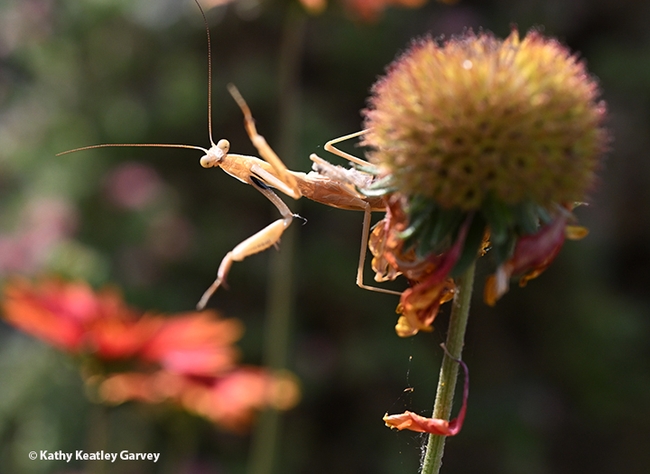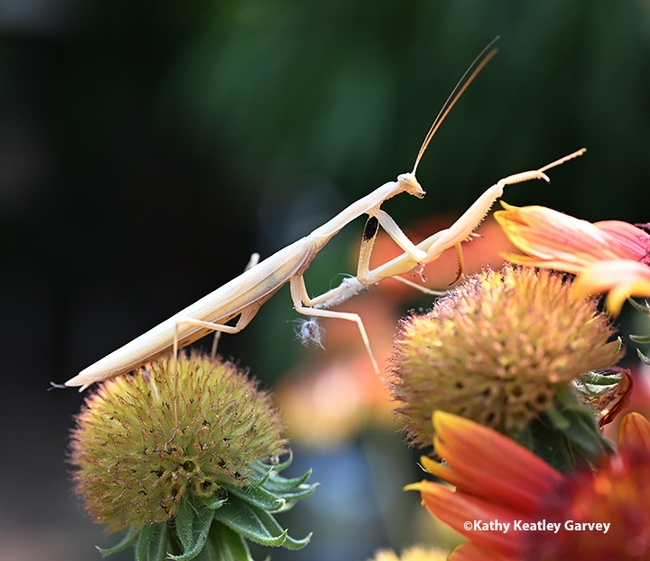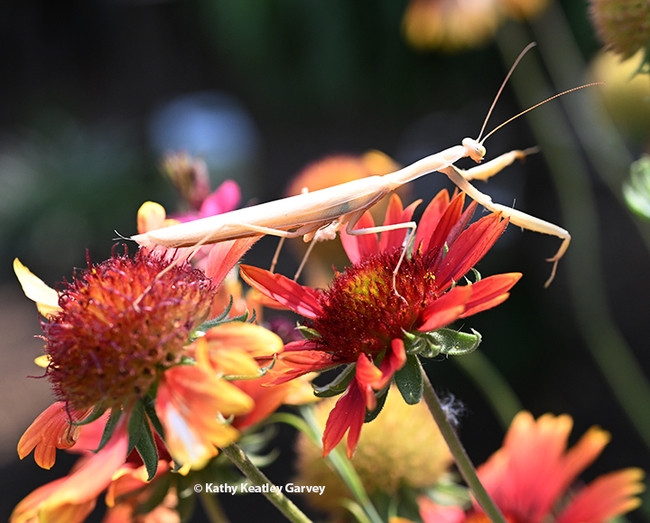
He's a male Mantis religiosa, as slim as a string bean, and scanning his environment.
We're accustomed to seeing see the native Stagmomantis limbata in our garden, and not M. religiosa, the European mantis, which is found throughout Europe, Asia, Africa, and North America.
"Males are often found to be more active and agile, whereas females are physically more powerful," according to Wikipedia. "Adult females are generally too large and heavy for their wings to enable a take-off...The great variation in the coloration of M. religiosa from different shades of yellow, brown, green, and sometimes black has been the cause of numerous hypotheses and studies for over 100 years.However, no generally accepted answer about reason, benefit, or mechanism of the coloration or the change of coloration has been found."
The male is apparently quite good at avoiding sexual cannibalism during mating. Wikipedia says: "Instead of just observing them, sexually mature males approach sexually mature females when they see them, but due to the physical superiority of the females, males of M. religiosa face certain challenges in doing so. When a female spots a male, she is very likely to attack and kill him (see also: Sexual cannibalism). Therefore, males can be observed to be very slow and cautious in their approach; after spotting a female, the male usually freezes and turns his head to look directly at her. Since the foveae in his eyes face directly forwards, he has the most accurate and detailed view of her and can watch every one of her moves. He then proceeds to approach her from behind. Males can be observed to stop as soon as the female turns her head or even moves. Mantids are very good at detecting moving structures, but are almost unable to see immobile objects. Using this ‘stop-and-go' tactic, the male stalks closer to the female. This can often take several hours. Depending on the environment, males sometimes show a light ‘rocking'-behavior which is believed to imitate the leaves of surrounding plants to blend in with the background. Males doing this had no higher probability of being detected and attacked, which supports this hypothesis of concealment."
We asked praying mantis scientist Lohit Garikipati about this European species. He holds a bachelor's degree from UC Davis and a master's degree from Towson University, Md., and is now PhD-bound at the Richard Gilder Graduate School in the American Museum of Natural History in the Jessica Ware lab.
"In my time at Davis I observationally did--they hold a special place for me as they were the first species that ever kept and raised in captivity!" said Garikapti, who shared his mantises and expertise at the Bohart Museum of Entomology open houses. "But they also highlighted to me the potential impact of invasive species on both native mantis species but also prey populations--as low foliage and ground dwelling predators, they have a different niche from S. limbata, and may be contributing to the decline of native Litaneutria (even as they have for the California mantis, Stagmomantis wheelerii). Adult females have also been observed feeding on fence lizards, without much apparent effort as they can take lizards even larger than they are. All of these factors combined with their cryptic ooth (ootheca) deposition and large clutch size have made them one of the most if not the most successful mantis species on the planet - they tolerate both cold and hot climates being found in deserts to temperate forests and now have a Holarctic distribution."
Garikipati related that in the Ware lab, he will be "investigating the evolutionary relationships of praying mantises and what drove their diversity."
We look forward to hearing more from Lohit! As for our buddy, the male M. religiosa, he took flight. (See video on YouTube).
Attached Images:


